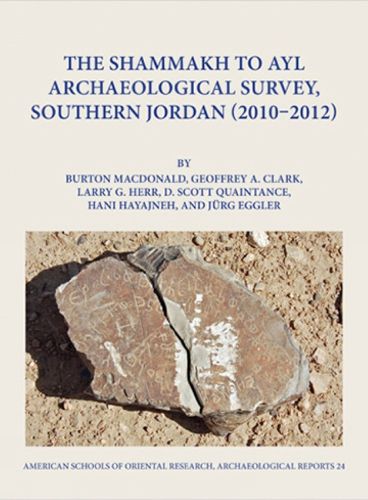Readings Newsletter
Become a Readings Member to make your shopping experience even easier.
Sign in or sign up for free!
You’re not far away from qualifying for FREE standard shipping within Australia
You’ve qualified for FREE standard shipping within Australia
The cart is loading…






Analysis of the materials, primarily lithics and sherds, collected in the course of this project indicate that the area experienced its highest density of population during the Middle Paleolithic, Neolithic/Chalcolithic, Iron II, Nabataean and Roman, Byzantine, and Late Islamic periods.
Relative to the settlement patterns of the area, it can be concluded that the area was a rural one where the chief activities were agriculture and pastoralism. The many farms, hamlets, villages, and camp sites documented show that the area most probably provisioned, during various archaeological periods, the major international sites of the area.
The project has particular relevance for understanding the major site of Petra during the Nabataean, Roman, and Byzantine periods. In addition, it is important relative to the site of Udhruh during these three periods plus the Early and Late Islamic periods and the site of ash-Shawbak, located immediately to the north of the project’s territory, during the Middle Islamic period.
The objectives of The Shammakh to Ayl Archaeological Survey, Southern Jordan project were:
to discover, record, and interpret archaeological sites in an area of approximately 590 km between Shammakh in the north and Ayl in the south in the southern segment of the Transjordan Plateau;
to determine the area’s settlement patterns from the Lower Paleolithic (ca. 1.4 mya) to the end of the Late Islamic period (AD 1918); to investigate the Pleistocene (as late as ca. 10,000 B.C.) sediments and lakes in the eastern segment of the survey territory;
to document the many farms, hamlets, and villages that provisioned the major international sites of the area, for example, Ash-Shawbak, Petra, and Udhruh;
to investigate further the Khatt Shabib or ‘Shabib’s Wall,’ a low stone wall running in a generally north-south direction through the area;
to record the inscriptions, rock drawings, and wasms (tribal brands) within the area;
and to link up with previous work that the project director and others have carried out in southern Jordan.
These objectives were accomplished by the transecting of 108 random squares and the documenting of 366 sites that range in date from the Lower Paleaolithic to the end of the Late Islamic period. Finally, the project contributed to the writing of the archaeological history of southern Jordan from Wadi al-Hasa in the north to Ras an-Naqab in the south and from the desert on the east to the international border between Jordan and Israel on the west.
$9.00 standard shipping within Australia
FREE standard shipping within Australia for orders over $100.00
Express & International shipping calculated at checkout
Analysis of the materials, primarily lithics and sherds, collected in the course of this project indicate that the area experienced its highest density of population during the Middle Paleolithic, Neolithic/Chalcolithic, Iron II, Nabataean and Roman, Byzantine, and Late Islamic periods.
Relative to the settlement patterns of the area, it can be concluded that the area was a rural one where the chief activities were agriculture and pastoralism. The many farms, hamlets, villages, and camp sites documented show that the area most probably provisioned, during various archaeological periods, the major international sites of the area.
The project has particular relevance for understanding the major site of Petra during the Nabataean, Roman, and Byzantine periods. In addition, it is important relative to the site of Udhruh during these three periods plus the Early and Late Islamic periods and the site of ash-Shawbak, located immediately to the north of the project’s territory, during the Middle Islamic period.
The objectives of The Shammakh to Ayl Archaeological Survey, Southern Jordan project were:
to discover, record, and interpret archaeological sites in an area of approximately 590 km between Shammakh in the north and Ayl in the south in the southern segment of the Transjordan Plateau;
to determine the area’s settlement patterns from the Lower Paleolithic (ca. 1.4 mya) to the end of the Late Islamic period (AD 1918); to investigate the Pleistocene (as late as ca. 10,000 B.C.) sediments and lakes in the eastern segment of the survey territory;
to document the many farms, hamlets, and villages that provisioned the major international sites of the area, for example, Ash-Shawbak, Petra, and Udhruh;
to investigate further the Khatt Shabib or ‘Shabib’s Wall,’ a low stone wall running in a generally north-south direction through the area;
to record the inscriptions, rock drawings, and wasms (tribal brands) within the area;
and to link up with previous work that the project director and others have carried out in southern Jordan.
These objectives were accomplished by the transecting of 108 random squares and the documenting of 366 sites that range in date from the Lower Paleaolithic to the end of the Late Islamic period. Finally, the project contributed to the writing of the archaeological history of southern Jordan from Wadi al-Hasa in the north to Ras an-Naqab in the south and from the desert on the east to the international border between Jordan and Israel on the west.